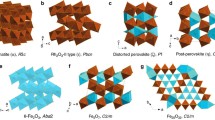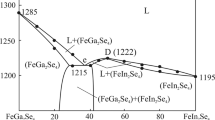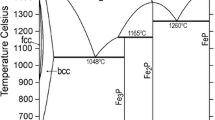Abstract
The cluster variation method, in the single prism approximation, is used to model phase relations in the system, Fe2O3-FeTiO3. Ordering in FeTiO3 is analyzed, and it is shown that the stabilization of FeTiO3 (relative to mechanical mixing of Fe2O3 and Ti2O3) includes: (1) a contribution from the redox reaction, Fe3++Ti3+→Fe2++Ti4+ (ΔH redox∼−70kJ mole−1); and (2) a contribution from ordering (ΔH OD∼−8kJ mole−1). A theoretical phase diagram is presented and compared with available experimental data. Semiquantitative agreement between theory and experiment (on the location of phase boundaries) is achieved; but, owing to the paucity of experimental data on coexisting phases, these results may be fortuitous.
Similar content being viewed by others
References
Allen SA, Cahn JW (1976) On tricritical points resulting from the intersection of higher-order transitions with spinodals. Scr Metall 10:451–454
Blake RL, Hessevic RE, Zoltai T, Finger LW (1966) Refinement of the hematite structure. Am Mineral 51:123–129
Burton BP (1982) Thermodynamic analysis of the systems CaCO3-MgCO3, α-Fe2O3, and Fe2O3-FeTiO3. PhD thesis, State University of New York, Stony Brook, New York
Burton BP, Kikuchi R (1984a) Thermodynamic analysis of the system CaCO3-MgCO3 in the tetrahedron-approximation of the cluster variation method. Am Mineral 69:165–175
Burton BP, Kikuchi (1984b) The antiferromagnetic-paramagnetic transition in αFe2O3 in the single prism approximation of the cluster variation method. Phys Chem Mineral 11:125–131
El Goresy A (1976) Oxide minerals in lunar rocks; Opaque oxide minerals in meteorites. In Rumble DR (ed) Oxide Minerals, Reviews in Mineralogy 3, Mineralogical Society of America, pp EG1–EG72
Goodenough JB (1960) Direct cation-cation interactions in several oxides. Phys Rev 117:1442–1451
Haggerty SE (1976) Oxidation of opaque mineral oxides in basalts. In Rumble DR (ed) Oxide Minerals, Reviews in Mineralogy 3, Mineralogical Society of America, pp Hg1–Hg100
Ishikawa Y (1958) An order-disorder transformation phenomena in the FeTiO3-Fe2O3 solid solution series. J Phys Soc Jpn 13:828–837
Ishikawa Y, Syono Y (1963) Order-disorder transformation and reverse thermo-remanent magnetism in the FeTiO3-Fe2O3 system. J Phys Chem Solids 24:517–528
Kikuchi R (1951) A theory of cooperative phenomena. Phys Rev 81:988–1003
Kikuchi R (1974) Superposition approximation and natural iteration calculation in cluster-variation method. J Chem Phys 60:1071–1080
Kikuchi R (1976) Natural iteration method and boundary free energy. J Chem Phys 65:4545–4553
Lawson CA, Nord GL, Dowty E, Hargraves RB (1981) Antiphase domains and reverse thermoremanent magnetism in ilmenite-hematite minerals. Science 213:1372–1374
Lindsley DH (1973) Delimitation of the hematite-ilmenite miscibility gap. Geol Soc Am Bull 84:657–661
Lindsley DH (1976) The crystal chemistry and structure of oxide minerals as exemplified by the Fe-Ti oxides; Experimental studies of oxide minerals. In Rumble DR (ed) Oxide Minerals, Reviews in Mineralogy 3, Mineralogical Society of America, pp L1–L88
Reeder RJ, Nakajima Y (1982) The nature of ordering and ordering defects in dolomite. Phys Chem Minerals 8:29–35
Rice CE, Robinson WR (1977) High-temperature crystal chemistry of Ti2O3: structural changes accompanying the semiconductor-metal transition. Acta Crystallogr B33:1342–1348
Robie RA, Hemingway BS, Fisher JR (1979) Thermodynamic properties of minerals and related substances at 298.15 K and at higher temperatures. Geological Survey Bulletin 1452. pp 302–306
Rumble D (1976) Oxide minerals in metamorphic rocks. In Rumble DR (ed) Oxide Minerals, Reviews in Mineralogy 3, Mineralogical Society of America, pp R1–R24
Sanchez JM, de Fontaine D (1980) Ordering in fcc lattices with first- and second-neighbor interactions. Phys Rev Sect B 21:216–228
Shirane G, Pickart SJ, Nathans R, Ishikawa Y (1959) Neutron-diffraction study of antiferromagnetic FeTiO3 and its solid solutions with α-Fe2O3. J Phys Chem Solids 10:35–43
Syono Y, Yamauchi H, Ito A, Someya Y, Ito E, Matsui Y, Masaki A, Akimoto S (1980) FERRITES: Proceedings of the international conference, September-October Japan 192–195
Van Baal CM (1973) Order-disorder transformations in a generalized Ising alloy. Physica (Utrecht) 64:571–586
Warner BN, Shive PN, Allen JL, Terry C (1972) A study of the hematite-ilmenite series by the Mossbauer effect. J Geomag Geoelectr 24, 353–367
Wechsler BA, Prewitt CT (1984) Crystal structure of ilmenite (FeTiO3) at high temperature and at high pressure. Am Mineral 69:176–185
Author information
Authors and Affiliations
Rights and permissions
About this article
Cite this article
Burton, B. Thermodynamic analysis of the system Fe2O3-FeTiO3 . Phys Chem Minerals 11, 132–139 (1984). https://doi.org/10.1007/BF00309251
Received:
Issue Date:
DOI: https://doi.org/10.1007/BF00309251




